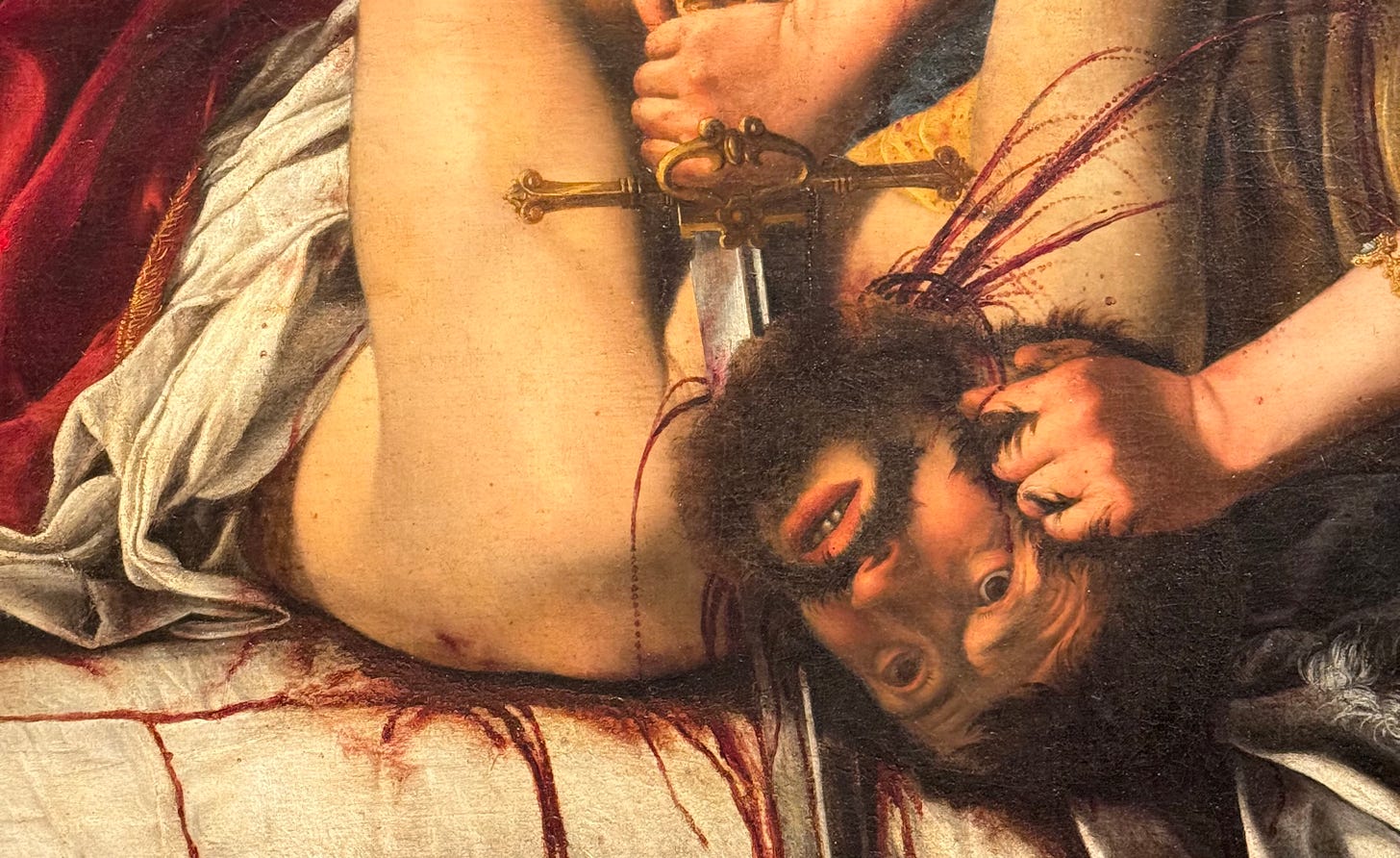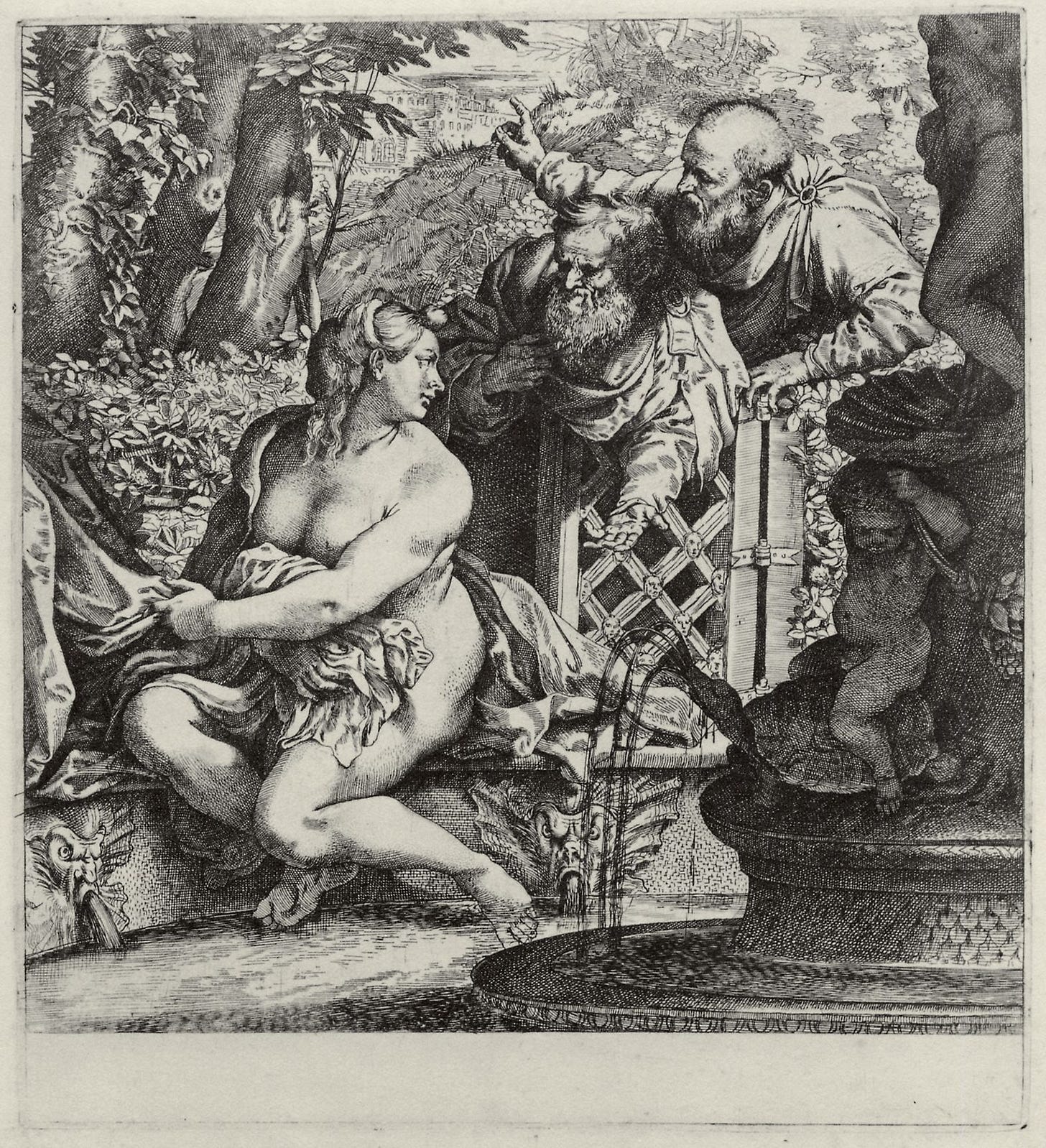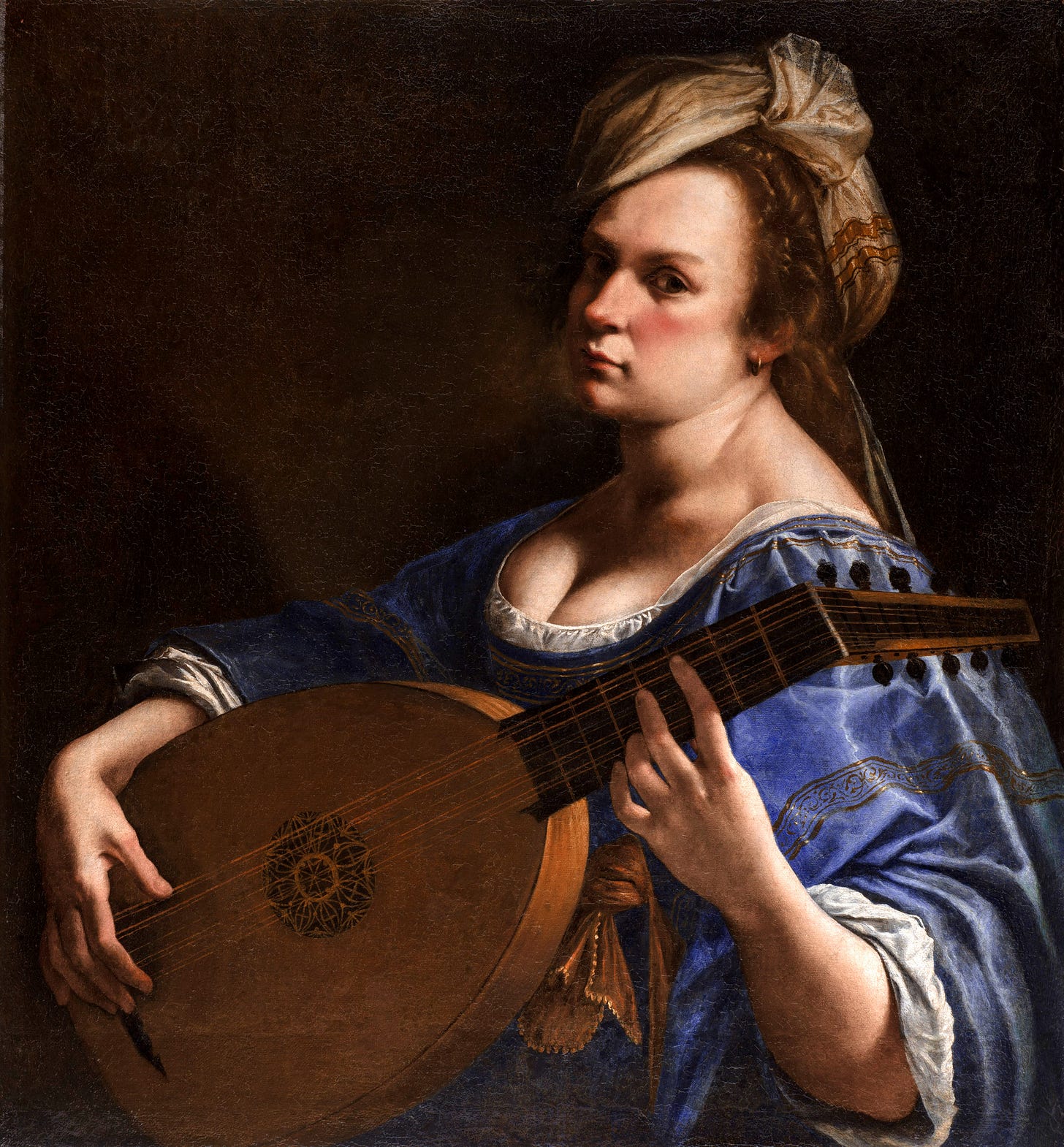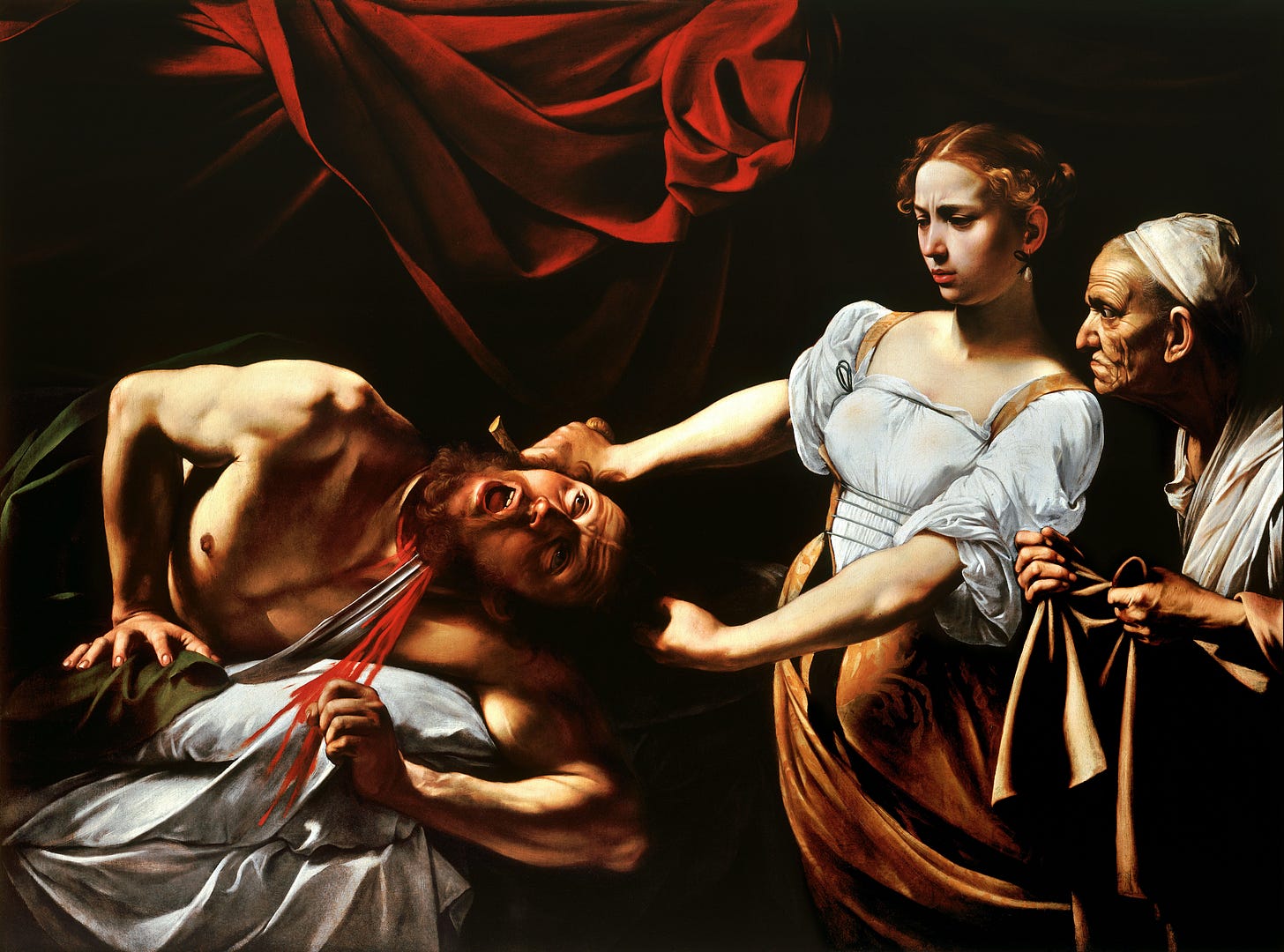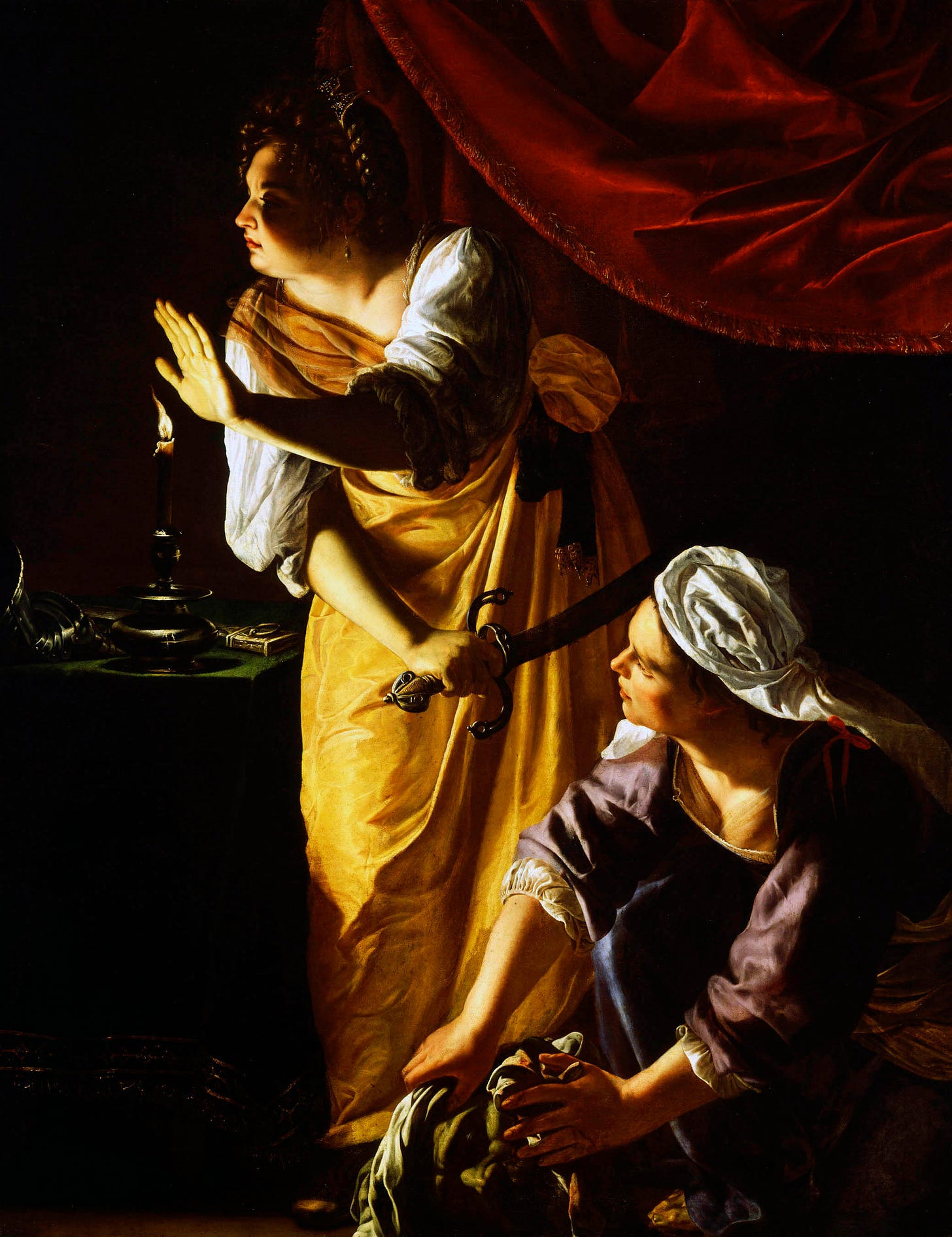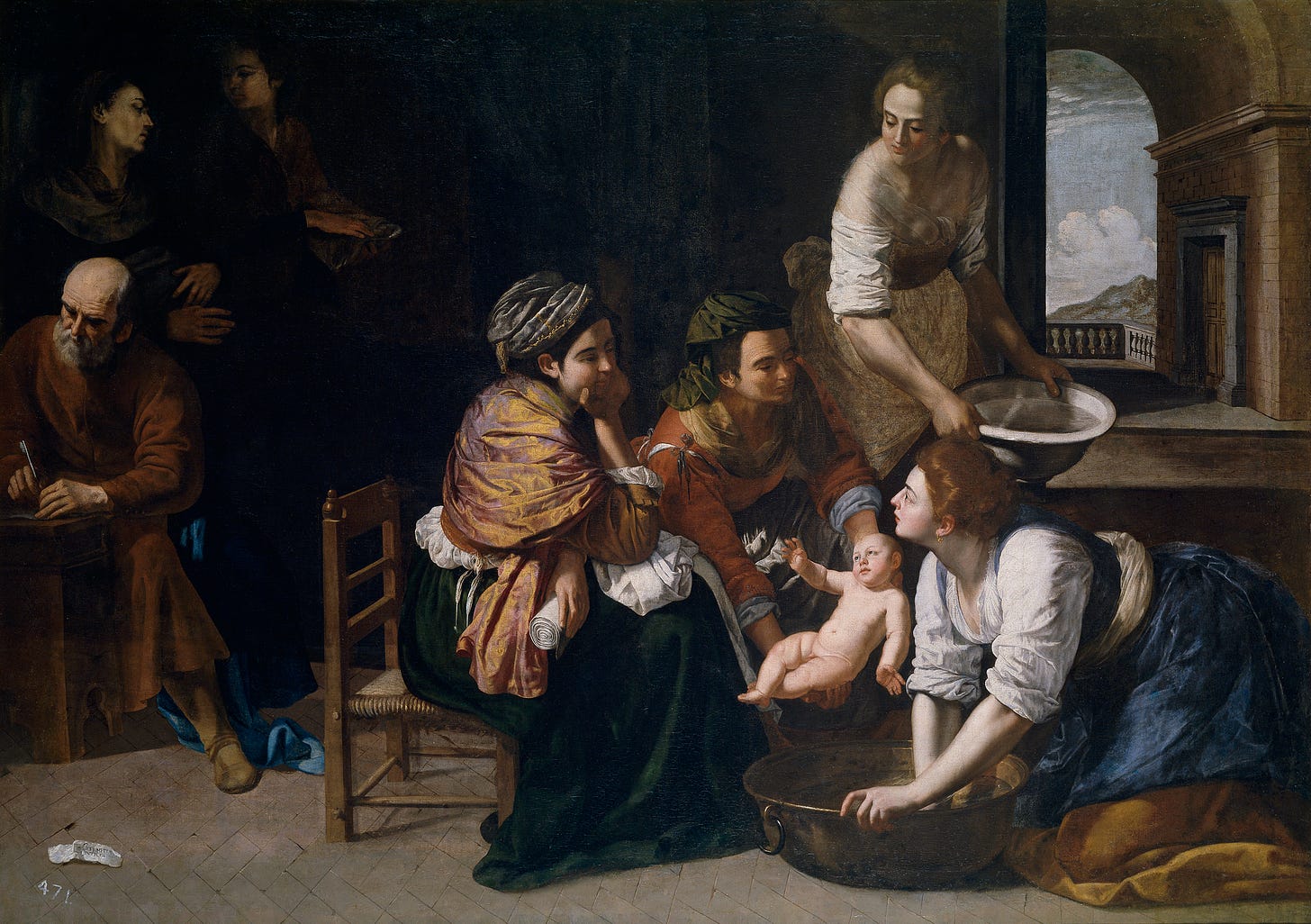Welcome to art Snacks, a newsletter serving bite-sized art history morsels to hungry adults.
On a brisk January morning in Florence, still buzzing from a breakfast latte from Cafe Gilli, I found myself strolling the lower floor of the Gallerie degli Uffizi. Housed in a former Medici “office” building and abutting the banks of the River Arno, the Uffizi is a jewel box of early Gothic and Renaissance heavyweights: Ciambue, Botticelli, Michaelangelo, and the other Ninja Turtles.
After the fireworks of the upper floors (the color! the angel wings! the gold leaf!), I found myself walking through the long, pink, corridors of the ‘self-portrait’ galleries. Portrait after portrait, room after room of aging, drab, male artists clad in black, the only deviation — their caps and collars and facial hair.
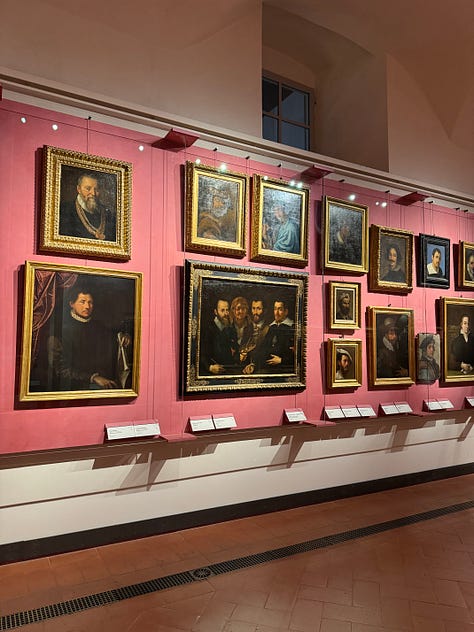
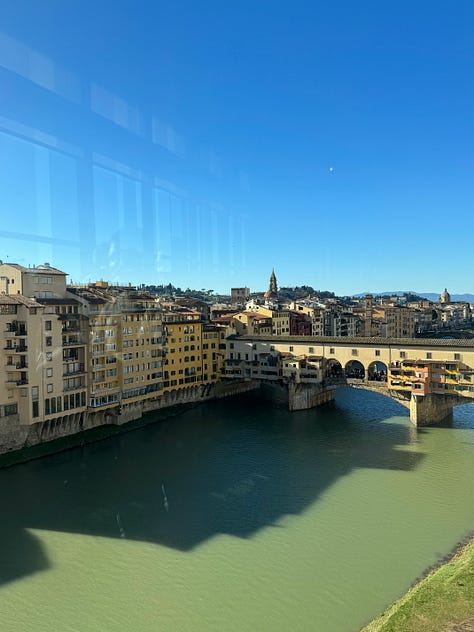
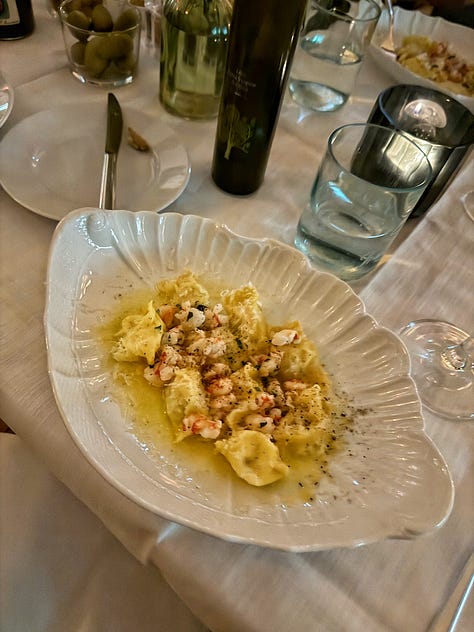
As I strolled—it’s a long walk to get through these galleries—I wondered, just how many female artists working before the 1900s could I name? Until recently, when I made it my mission to learn all about said women, probably just three. But at the top of any list would always be Artemisia Gentileschi (1593-1656). It was her work, Judith Beheading Holofernes, shocking, vivid and sensationally bloody, that I was here to see.
In Linda Nochlin’s groundbreaking 1971 essay, “Why Have There Been No Great Women Artists” Nochlin explains the structural obstacles faced by female artists across history. For centuries women were banned from life drawing classes (how else do you learn to draw the human form? derivatively, by copying sculptures, it turns out), weren’t able to roam outside unaccompanied (restricting their ability to study art in churches or gather inspiration from nature) and were denied membership to the great art academies. Women weren’t taught mathematics, fundamental to understanding perspective, and, critically, couldn’t apprentice in an artist’s workshop.
Yet, despite this, the precociously talented Artemisia Gentileschi found a way to flourish. She was considered one of the greatest painters of her time (Baroque) and was the first woman to be accepted to the Accademia di Arte del Disegno in Florence. She ran her own studio, negotiated her own commissions, and earned patronage from the Medici Court for her large-scale, dramatic works that put heroic female figures at their center.
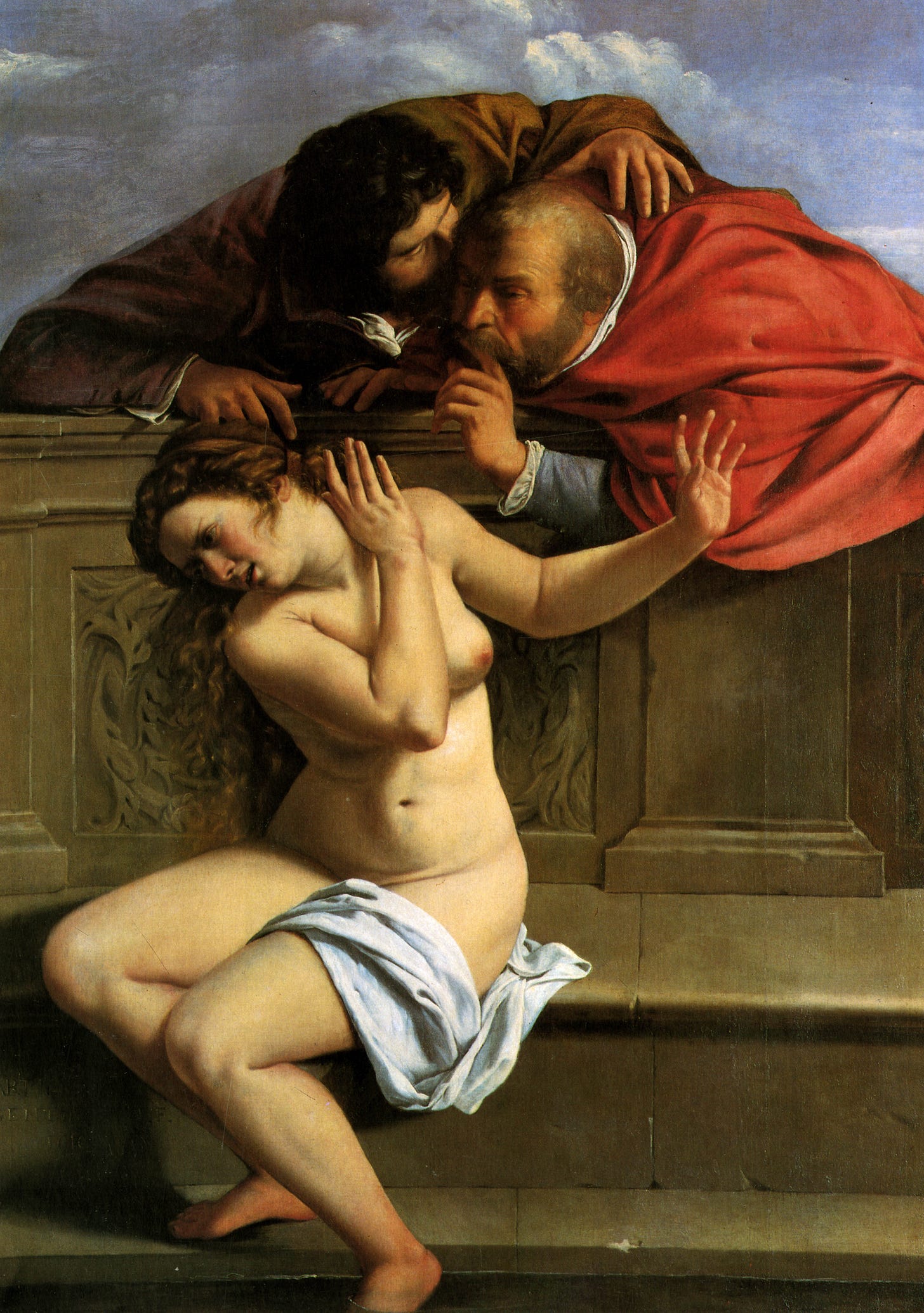
Artemisia Gentileschi was born in 1593 in the somewhat lawless artist’s quarter of Rome, between the city’s Northern Gate and the Tiber. From her tweens on, she helped her father—the established artist Orazio Gentileschi—crush and mix pigments and prepare canvasses in his workshop. Thanks to Orazio’s protection and tutelage, Artemisia was able to apprentice; learning how to paint nature and buildings, figures, flesh and drapery. At first, she was only allowed to assist with the less important aspects of his paintings (backgrounds, minor figures, limbs but not faces) but as she rapidly showed emerging signs of major artistic talent, her purview expanded.
Artemisia’s earliest known work, Susanna & The Elders, above, was painted when she was only seventeen. Type “Susanna and the Elders” into a Google image search and you’ll see a plethora of Renaissance and Baroque works. Most are set in bountiful nature, most show Susanna staring coyly at the voyeurs, interrupted but not that alarmed (see Carracci, below). But for the first time, Artemesia portrays this Biblical story from a female perspective. Susanna is distressed. Clearly so. She jerks her head away awkwardly, shielding her body while pushing away her pursuers. Her painting shows remarkable technical prowess, empathy and psychological intensity for an artist who was still a teenager.
A year after this painting’s completion, Artemisia was raped by her father’s assistant, Agostino Tassi. The Gentileschis took Tassi to court and a lengthy legal battle ensued. During the trial, Artemisia was questioned while subjected to a sibille—a form of thumbscrew-torture-cum-lie-detector—where ropes were laced across her fingers and systematically tightened, restricting circulation and exerting excruciating pain. (The court believed she’d ‘tell the truth’ under this duress.) From the 300 pages of handwritten and illustrated court documents, we know that as the sibille tightened, Artemisia shouted to the courtroom, “e vero! e vero! e vero!” (It’s true! It’s true! It’s true!) referring to Tassi’s crimes.
The Gentileschis won the trial and Tassi was banished from Rome, although his banishment was not properly enforced. Orazio immediately shifted his focus to finding a suitable husband for Artemisia, realizing that marriage was the most effective way to rehabilitate his daughter’s damaged reputation. After some inquiries, Orazio settled upon minor Florentine painter, Pierantonio Stiattesi (who was likely encouraged down the aisle by a large dowry and Artemisia’s clear promise as a painter/money-maker), as his future son-in-law. Crucially for Artemisia, Stiattesi would afford her protection over her artistic practice and give her access to a studio.
The wedding happened quickly. Orazio feared that Tassi or his friends would jeopardize the marriage (perhaps by busting in and roughing up the groom) and so the ceremony was conducted in secret: at night, in a side chapel of Santo Spirito in Sassia, Rome. There were only three attendees—Artemisia, Stiattesi and Orazio. In a highly unusual move for the time, the priests locked the doors to the church as an extra precaution.
After the wedding, Artemisia moved to Florence with her new husband, where she hit her artistic stride. She produced huge biblical and mythological scenes with dramatic light effects and an abundance of female subjects. Unlike her peers, her images were imbued with a female perspective, that of being persecuted, underestimated or wronged. Many of her works included aspects of self-portraiture and many featured hands: women’s hands working and in action! A great example is Self Portrait as a Lute Player, above, where we see Gentileschi’s hands, dexterously playing the lute—those same hands that were the authors of her work and purpose, that made her money, that were tortured during her trial. The women of the Medici Court were drawn to her work. Soon Cosimo De Medici and Charles I were among her patrons.
In the Uffizi, Gentileschi’s Judith Slaying Holofernes—where Judith beheads Assyrian general Holofernes, who is about to ruin the Jewish people, in his sleep—was even more imposing than I’d expected. The piece—which for decades had been placed beyond prime view due to its distasteful nature: too bloody, peripheral author—was now hung prominently at the start of the Caravaggio galleries. I was excited to see a small cluster of mostly women, hovering around it, taking photos on their iPhones.
(It’s worth noting, that while ultra-successful during her lifetime, post-death, Gentileschi was forgotten until a radical exhibition in 1975 at LACMA. The show, “Women Artists 1550—1950,” was curated by Linda Nochlin and Ann Sutherland Harris and featured works by Gentileschi. Almost 50 years after this ‘rediscovery’ Gentileschi’s reputation is now being restored, her works are sold for millions and collections are re-evaluating her paintings long held in their dusty storage rooms.)
Judith, muscular, is seen in the middle of hacking through Holofernes’ neck. The scene is depicted at the moment of action unlike many works on this theme which show the moments after the beheading—usually Judith’s maidservant holding Holofernes’ decapitated head. Here, Holofernes is still alive, his arm thrust upwards in a final attempt to push away Judith’s accomplice/maidservant. His hair protrudes in tufts from Judith’s fingers, his blood splatters across her chest. The rivulets of spurting, streaming blood are incredibly life-like. But Judith’s face, so precisely illuminated, is calm and unflinching. There’s no question that she’s getting the job done. One has to wonder whether Gentileschi was sending Agostino Tassi (and his ilk) a not-so-subtle message: do not underestimate the lady-folk.
Compare Gentileschi’s painting to Caravaggio’s on the same subject (Caravaggio was Artemisia’s contemporary and his radically bold introduction of chiaroscuro had influenced many of his peers, including Artemisia’s father).
Despite the dramatic chiaroscuro and the naturalistic faces, Caravaggio’s scene doesn’t pack the same punch. Judith looks mildly grossed out—neither disgusted nor in full, cold-blooded control—as if she were killing a spider. She’s leaning outwards vs. leaning in and honestly doesn’t seem to be putting her back into it. The painting lacks something that Gentileschi’s is awash with: the perspective of a female enraged, yet confidently able to take a situation into her own hands, avenging herself or her people; a woman not OK with simply being a victim.
There is debate regarding when Judith Slaying Holofernes was painted, but a good guess is between 1614 and 1620. During part of this period 1613 - 1618, we know that Gentileschi gave birth to five successive children, four of whom died before they reached five, and only one, born in 1617, of whom lived into adulthood. It’s hard not to imagine the toll these pregnancies took on her, both physically and psychologically, as she executed numerous, massive, technical paintings.
Many art historians view Gentileschi’s work solely through the lens of the 1612 trial (a victim avenging herself with aspirational paintings of women decapitating men), but it seems obvious that motherhood would have been top of mind too. We see this explicitly in The Birth of Saint John The Baptist. In this biblical story, Zacharias and Elizabeth are too old to have children. However, the Angel Gabriel comes to the couple telling them they’ll have a son. Miraculously, they do, at which point Zacharias temporarily loses his ability to speak, from shock.
Rather than depicting the moment of receiving the news from the angel, or a family portrait, Gentileschi picks a quiet post-birth scene—one she’d have been intimately familiar with. Neighbors and midwives attend to the newborn, gently conferring with one another, surrounded by washcloths and basins—the domestic and practical utensils of the birth. They sit within the single source of light, the spotlight making clear this scene is about them. Elizabeth, presumably exhausted from just giving birth, realistically lies almost invisible, recuperating at the back of the scene.
Gentileschi’s life and career remained exciting and adventurous beyond her Florence years. She took a lover, traveled to England to paint for King Charles I, and thereafter moved to Southern Italy—a place she expressed continued dissatisfaction with. There is little primary evidence from Gentileschi’s final years. Art historians guess she died in Naples in 1656 during an outbreak of the plague which decimated half of the city’s population.
Gentileschi left behind at least 57 major paintings, 49 of which prominently feature women. Many focus on the themes of Susanna, Judith, Bathsheba, Lucretia, Cleopatra and Mary Magdalene: complex and multi-layered women, all brought to life from the female point of view.
It’s encouraging to watch Gentileschi’s legacy being systematically rehabilitated by a varied group of female art historians— women like Linda Nochlin and Ann Sutherland Harris who re-directed attention to her in the 1970s, Mary Garrad and Sheila Barker for their work unearthing her life and oeuvre, and Jane Fortune, Nicola McGregor and Letizia Treves who’ve recently uncovered, restored and exhibited Gentileschi’s masterpieces. Finally, Artemisia Gentileschi is getting the recognition she’s long deserved.
In case you’re still hungry…
Michael Palin’s Quest for Artemisia, BBC via YouTube (highly rec)
A Fuller Picture of Artemisia Gentileschi, The New Yorker
Artemisia’s place setting at Judy Chicago’s The Dinner Party, 1939
More Savage Than Caravaggio, The Woman Who Took Revenge in Oil, The Guardian
Bow Down Podcast, Helen Cammock on Artemisia Gentileschi






